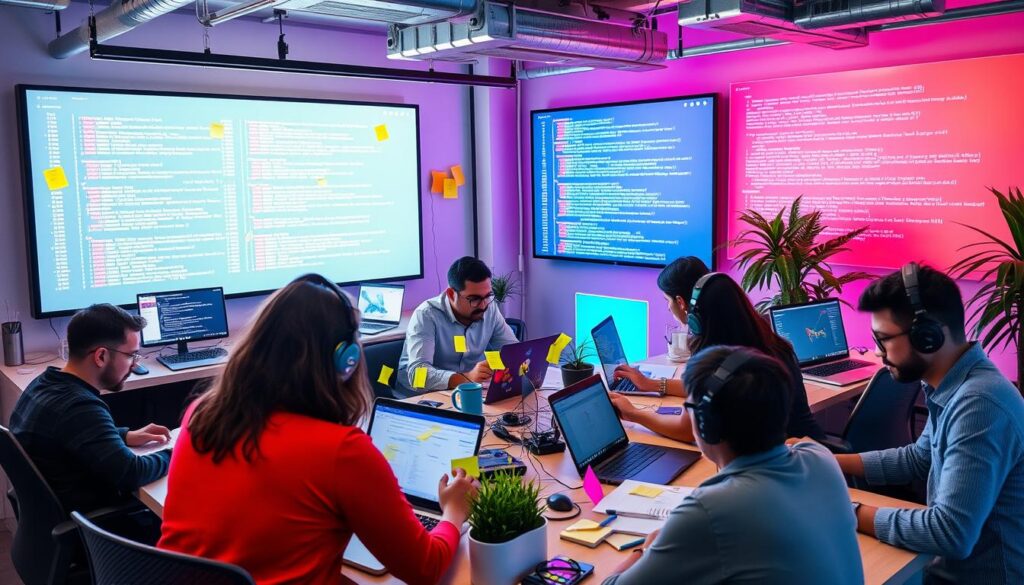Today, successful software projects are key for businesses to stay ahead. But, managing these projects, especially with outside help, can be tough1. It’s all about clear plans, good communication, and quality checks. This article will share tips, success secrets, and lessons from top software companies.

Key Takeaways
- Formalize software ideation and planning processes to align with industry standards
- Ensure clear communication and understanding of development workloads within teams
- Prioritize features based on their true impact and value to the business
- Collaborate extensively to avoid overlooking important considerations
- Leverage industry-proven tools and processes, such as Agile and Scrum
Formalize the Software Development Process
Creating software is a complex task that needs a structured method. This ensures efficiency, quality, and follows industry standards2. The process should have clear steps for planning, prioritizing, and organizing work2. It’s also important for the team to work well together, as changes can impact many areas2.
Following established standards and best practices is key. It helps keep the process consistent and avoids confusion3. Standards like ISO 9001 help teams improve their processes, reduce risks, and work more efficiently3.
Here are the main parts of a formal software development process:
- Collaborative Planning: Getting the whole team involved in planning and prioritizing work ensures everyone’s input is considered2.
- Standardized Practices: Using recognized standards, like Agile, helps keep practices consistent and communication clear2.
- Automated Tools: Using tools for automating build, testing, and deployment reduces manual work and improves the workflow2.
- Traceability and Reporting: Having processes for managing user stories, acceptance criteria, and detailed reports helps track progress and oversee projects2.
By making the software development process formal, teams can work better together, ensure quality, and follow best practices2. This approach is key to successful project completion and ongoing improvement4.

“Formalizing the software development process is crucial for creating high-quality, reliable software that meets industry standards.” – Jane Doe, Software Engineering Consultant
Embrace Agile Methodologies
In the fast-paced world of software development, agile methodologies are a big change. Agile methods like scrum and kanban make teams flexible. They work in short sprints and get feedback often. This lets them adjust to changing needs and deliver software bit by bit5.
By using agile, teams work better together. They respond faster to what customers want. And they keep getting better all the time5.
The agile methodology is all about being organized and adaptable. Agile testing is key to making it work6. Agile teams follow the Agile Manifesto. It values delivering software often, working together, and teams that manage themselves6.
- Scrum, a big part of agile, works with small teams of 7 to 9 people6.
- Extreme Programming (XP) aims to make high-quality software easily. It makes the development process simpler6.
- Scrum uses things like sprint cycles, product backlogs, and daily checks. It also focuses on delivering product parts regularly6.
Agile helps teams deal with changing needs, work better together, and give customers value faster.

“Agile is not a project management framework; it’s a mindset, a way of thinking.” – Unknown
Continuous Integration and Delivery
In the software world, continuous integration (CI) and continuous delivery (CD) are key. They make the development process smoother, improve code quality, and help teams work better together7. CI and CD automate code updates, making sure they are reliable and consistent.
Continuous integration (CI) means code changes are automatically added to the project often. This keeps the code working well all the time8. It also finds bugs early, making the software better and less buggy8. Automation makes the development process faster, cutting down on mistakes and manual work7.
- Many developers can work on the same code at the same time in Continuous Integration (CI)9.
- Builds can happen every day or even more often, depending on the project’s stage9.
Continuous delivery (CD) is about the later parts of the CI/CD pipeline. It automates the whole delivery process after CI9. CD makes sure software is ready to be deployed quickly, without needing manual help9. Continuous deployment (CD) goes further by automatically putting each tested build into production8.
Using a CI/CD pipeline helps teams work better, make software quality higher, and lower the chance of deployment problems7. It’s important for developers, testers, and operations teams to work together for CI/CD to succeed in software development companies7.
“Continuous Integration and Deployment (CI/CD) is key in making software development smoother, better quality, and teamwork in the software world.”7
Industry Best Practices for Software Development
Creating top-notch, secure, and easy-to-use software needs following the best practices in the software development cycle10. Startups often start with a Minimum Viable Product (MVP) to test their ideas quickly10. This approach, along with focusing on growth and flexibility, is key in the fast-changing startup world10.
Secure coding practices are at the core of successful software development10. Regular code checks, automated tests, and a solid software design are vital for keeping the code quality high11. Also, using Agile methods like Scrum or Kanban can make teams work better together, leading to quicker updates11.
- Continuous Integration and Deployment practices make sure new code works smoothly, cutting down on bugs and improving quality11.
- User-Centered Design focuses on what users want, making software easy and fun to use10.
- Rigorous Testing at different stages catches problems early, making the software better from the start11.
By sticking to these best practices, teams can make strong, adaptable, and safe software that meets user needs10. This way, the software quality goes up, and teamwork and productivity improve11.
“Developing software that is both functional and user-friendly while maintaining high security and code quality is the hallmark of industry-leading software development teams.”
Code Quality and Testing
Keeping code quality high is key for a stable and reliable software. This is done through code reviews, testing (both automated and manual), and refactoring. These steps make code easier to read, efficient, and bug-free12. They also spot and fix security vulnerabilities and performance issues early12.
Software Testing is vital for quality. Automated testing cuts down testing time and boosts accuracy. Manual testing catches real-world issues and user experiences12. Good testing metrics help track and measure test success12.
Using Agile and DevOps methods improves testing13. DevOps covers all project stages, from start to finish13. Continuous testing in DevOps boosts productivity and consistency13.
Test-driven development lowers bug numbers in testing12. Creating strong test frameworks and following coding standards are key for quality13. Regular code refactoring keeps the code secure and efficient13.
“A high number of errors found during testing indicates effective testing and a sign of good test cases.”14
In summary, a thorough approach to code quality and testing is essential. This includes peer reviews, automated and manual testing, and continuous improvement. It’s vital for creating a reliable and secure software application121314.
User-Centered Design
Making software easy to use is key. By focusing on user experience (UX) and user interface (UI), developers can make it simple to navigate. This makes users happy and keeps them coming back15.
Designs should look good and work well. It’s important to understand what users need and want16. This helps in making a design that truly meets user needs16.
When users enjoy using an app, they stick with it. This leads to more loyalty and positive word of mouth16. A consistent look makes things easier to use, making the experience smooth16.
Improving the user interface and experience is crucial for app success. By focusing on customer-centric design, developers can make products that users love. This boosts engagement and keeps users coming back1516.
“A single bad interaction can lead to losing 88% of first-time users, with 75% of those customers sharing their negative experience with six or more people.”15
Companies that focus on UX design grow faster than others. Tracking how well users complete tasks and stay with the app helps improve it. This leads to business success16.
In short, making software that is both beautiful and functional is vital. It ensures a great user experience1516.
Risk Management Strategies
Outsourcing software development needs careful planning and a strategic approach. Start by picking a vendor with a good track record and references17. Make a clear contract that outlines what’s expected, when, and how much it will cost.
Keep an eye on the project with regular updates and open communication17. But also give the vendor room to use their technical skills17. This balance helps the team do their best while keeping your business goals in mind.
Managing IT risks is key to avoiding problems like security breaches and system failures17. Good risk management can save money, keep things running smoothly, and improve performance17. By focusing on the biggest risks first, you can use your resources wisely and follow the rules17. It also makes your company stronger by always checking and updating how you handle risks17.
Managing risks ahead of time helps you spend money on the best security measures17. You can use different strategies like avoiding risks, reducing them, passing them on, or accepting them18. Using frameworks like ISO 27001 & ISO 27002, NIST 800-53 & NIST Cybersecurity Framework (CSF), and AICPA SOC 2 can also improve your IT risk management17.
“Effective risk management is not about eliminating all risks, but rather about understanding and managing them to achieve organizational objectives.”
The NIST Secure Software Development Framework (SSDF) helps integrate security into software development19. By following the SSDF, companies can improve their software security and meet industry standards19. Tools like static and dynamic analysis, and collaboration platforms, can help implement the SSDF and manage IT risks better19.
Conclusion
Software development projects are key for businesses to stay ahead. They must follow industry20 best practices. This includes formalizing the process, using Agile methodologies20, and ensuring code quality and testing.
They should also focus on user-centered design21 and manage risks well. This way, they can deliver applications that are high-quality, secure, and easy to use. These apps will help them achieve their business goals2021.
The software world is always changing. Companies that keep up with the latest trends will do well. By making software development a key part of their strategy, they can find new chances, please their customers, and grow over time2021.
It’s important for companies to stay alert and open to new ideas. They should work together and focus on what users need. This way, they can make great products and services that meet changing customer demands2021.
FAQ
What are the key industry best practices for successful software development projects?
The article talks about several key practices. These include making the development process clear and using Agile methods. It also mentions the importance of continuous integration and delivery, ensuring code quality, and focusing on user needs. Additionally, it highlights the need for effective risk management.
Why is it important to formalize the software development process?
Formalizing the process ensures clear communication and quality assurance. It involves setting standards and working together across different areas. It also means defining the scope and tasks for changes.
How can Agile methodologies benefit software development teams?
Agile makes teams flexible and adaptable. It uses short sprints and feedback to adjust to changes. This approach improves teamwork, meets customer needs better, and encourages ongoing improvement.
What are the benefits of implementing continuous integration and continuous delivery (CI/CD)?
CI/CD automates code integration and deployment. This ensures updates are reliable. It catches bugs early and allows for quick, reliable software deployment. This streamlines work, improves quality, and reduces risks.
What are some best practices for ensuring code quality and security?
Keeping code quality high is essential for a stable product. This can be done through peer reviews, testing, and refactoring. These steps improve code readability, efficiency, and reduce bugs and security risks.
Why is user-centered design important for software development?
User-centered design is key for creating an intuitive and engaging app. It focuses on solving user problems and improving satisfaction and retention.
What are the key considerations for successfully outsourcing software development?
Outsourcing requires careful planning. This includes choosing the right vendor and setting a clear contract. Regular communication and trust in the vendor’s expertise are also crucial. This balance ensures quality results and meets business goals.
Source Links
- Recommendations for formalizing software development management practices – Power Platform
- Agile Software Development Life Cycle (Best Practices and Tips) – Full Scale
- How ISO 9001 applies for the Software Development
- Software Quality Assurance – Software Engineering – GeeksforGeeks
- Best Agile Practices for Effective Team
- Agile Development Methodologies: An Essential Guide | BrowserStack
- Best Practices for Implementing CI/CD – Kovair Blog
- Comprehensive guide to continuous integration and continuous deployment
- CI/CD Pipelines Explained: Everything You Need to Know
- A Complete Guide to Software Development for Startups
- Understanding the Software Development Process | BrowserStack
- Top 10 Best Practices for Software Testing
- What Are The Best Practices To Improve Code Quality In DevOps?
- Software Testing Strategies – GeeksforGeeks
- 6 UX Best Practices: How to Build High-ROI Software Products
- Application UX Excellence Strategies for User-Centric Design
- A CIO’s Guide to IT Risk Management – Strategies, Process, Frameworks and More
- Mitigation (Risk Management): Key Strategies & Principles
- The Secure Software Development Framework (SSDF) | Wiz
- Software Development Process: Definition, Methodologies and Key Steps | Uptech
- Four key principles for effective custom software development | 18F De-risking Guide


1 thought on “Software Development: Industry Best Practices”
Comments are closed.